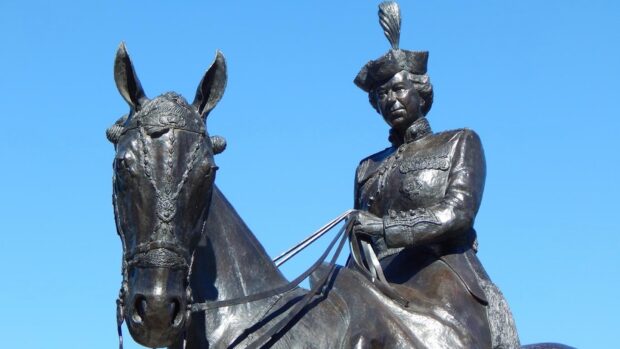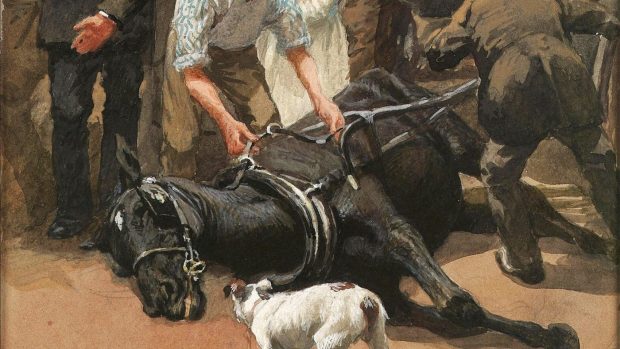The equine heroes of the First World War are being justly celebrated in a new exhibition at the National Army Museum (NAM). For the first time in a 100 years, Sir Alfred Munnings’ paintings of the horses of the Canadian Expeditionary Force, created in 1918 to record the battles fought and logistical work done by the soldiers and their horses is being shown in the UK, on loan from the Canadian War Museum.

Captain Prince Antoine of Orleans and Braganza. Wall number: A 4518112. Beaverbrook Collection of War Art
Munnings is of course famous for his impressionistic paintings of horses that capture the character of the creatures with bold brush strokes and surprisingly ingenious use of colour. Look out for the greens and blues he uses to indicate the way light and shadow hits the figure of a horse and you won’t be able to stop seeing these colours that you would not think to use in depicting your equine companion. (Unless you’re painting a grey after a particularly vigorous roll in the grass and dirt, of course.)

Lord Strathcona’s Horse on the March. Wall number: A 4517827. Beaverbrook Collection of War Art
In terms of Munnings’ subject matter, The Charge of Flowerdew’s Squadron shows what you might expect from a war artist; an evocatively shown charge towards enemy lines. The tragedy of the horses galloping towards certain death by superior enemy firepower is effectively captured through by their pinned back ears, their stumbling and the fact that some of them are riderless. But most of the equine paintings show the downtime between battles and what the horses were used more effectively for once it was realised that the days of horseback warfare belonged to a different time – transportation and logging.

The Charge of Flowerdew’s Squadron. Wall number: A 4518116. Beaverbrook Collection of War Art
The cavalry in fact ended up using the horses to get them into a battle whereupon they would dismount and fight on the ground. Even more usefully, the horses served as a means of transporting supplies and also helping with logging. As one caption next to a painting points out, the Canadian Forestry Corps that came over as part of the Canadian Expeditionary Force “helped to defeat the submarine… more surely than a fleet of ships”. Effectively by being able to log their own wood with the help of the Forestry Corps, the British were able to save valuable space on North American transport ships for the import of food and munitions.

A Canadian Trooper and his Horse (unfinished). Beaverbrook Collection of War Art
Munnings’s eye for detail and sensitivity to the character and breeds of the horses captures perfectly the patient, hardworking attitude of the stockier horses, faithfully hauling supplies and wood, compared to the more flashy, agile and noble look of the cavalry horses.

Horses and Chargers of Various Units. Beaverbrook Collection of War Art
To help flesh out these horses for exhibition attendees, the NAM has dug out of its stores gear used for these war horses. You can see a bridle trimmed with velvet for an officer’s horse, the nose bags these horses had to eat from to avoid getting ill from the bacteria-filled French farmland and the branding iron for the hoof, among other bits of memorabilia. (Gruesome fact: the branded horse hoof would be cut off and sent back to England after the horse died so the government could keep a tally of its equine property.)

Halt on the March by a Stream at Nesle. Wall number: A 4509768. Beaverbrook Collection of War Art
Munnings’ work is a joy to view for anyone who loves horses, so it is definitely worthwhile visiting the new exhibition at the NAM for that alone. If you’re interested in history and the military too, there’s just no excuse not to make a trip to see these works while they are over here from Canada.

A Black Team in the Jammer. Wall number: A 4518075. Beaverbrook Collection of War Art
Behind the Lines: Alfred Munnings, War Artist, 1918 is on at the National Army Museum, London until 3 March 2019 before it moves to the Munnings Art Museum in Dedham, Essex where it will be on show from 23 March – 3 November.

On the Edge of the Wood. Wall number: A 4518109. Beaverbrook Collection of War Art
For all the latest equestrian news and reports, don’t miss Horse & Hound magazine out every Thursday



